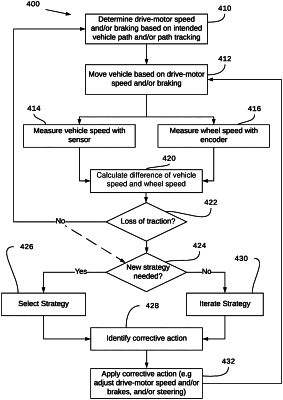| CPC B60W 30/18172 (2013.01) [G01C 21/26 (2013.01); B60K 7/0007 (2013.01); B60W 2420/42 (2013.01); B60W 2420/52 (2013.01); B60W 2520/10 (2013.01); B60W 2520/28 (2013.01); B60W 2710/081 (2013.01); B60W 2720/28 (2013.01); G05D 1/0231 (2013.01); G05D 1/027 (2013.01); G05D 2201/0213 (2013.01)] | 20 Claims |

|
1. A vehicle comprising:
at least one wheel for moving the vehicle;
at least one drive motor for driving the at least one wheel; and
a processor in communication with the at least one drive motor, the processor configured to:
control the at least one drive motor to move the vehicle along a path within an environment;
determine that, at a pre-determined time in the future, the vehicle will experience a condition associated with traction loss along the path;
evaluate the condition to determine a nature of the traction loss for the vehicle;
based on the nature of the traction loss and the vehicle:
determine one or more priorities for minimizing traction loss at the pre-determined time; and
select at least one traction-control strategy to address the one or more priorities from one or more traction-control strategies, wherein each traction-control strategy is assigned a score generated based on one or more previous applications of that traction-control strategy for the nature of the traction loss and the vehicle; and
at the pre-determined time:
implement a corrective action in accordance with the at least one traction-control strategy,
continue to evaluate a result of the corrective action; and
in response to determining the corrective action is ineffective, continue to determine a current priority for minimizing traction loss and to select a current traction-control strategy to address the current priority.
|